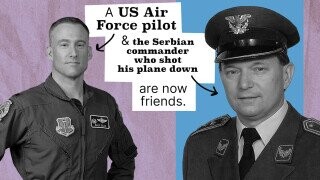5 Tales of Friendship Between Enemies During War

During war, two sides who disagree send their people to kill each other. Whichever side wins the fighting also wins the dispute. As a method for determining who’s right, it makes about as much sense as courts using trial by combat or political elections decided via tennis.
And so, every now and again, people on opposite ends of a conflict note the absurdity and say to themselves, “Hold on. Do I really hate that soldier on the other side?” Giving us stories like...
An American Captain Demanded a Proper Burial When a Kamikaze Fighter Hit His Ship
Don't Miss
On April 11, 1945, a plane flew into the USS Missouri, a battleship off Japan’s coast. It was a Japanese kamikaze attack, but it hurt no one other than the pilot. Far from sinking the 60,000 ton vessel, it just set a small fire on deck, which the sailors quickly extinguished. One man on the ship managed to snap a photo of the incoming plane. He was “Buster” Campbell, an assistant baker on the ship who specialized in yummy donuts, and if even he didn’t panic upon seeing the incoming plane, we can assume few on the Missouri feared it.

Harold Campbell
The ship now had to decide what to do with the dead pilot (believed to be named Setsuo Ishino, although Japan never officially identified him). They chose to bury him at sea. That’s not a euphemism for gleefully chucking the corpse in the water but rather a description of the formal funeral they held for the man. The bugler played “Taps.” A chaplain spoke. The men saluted. An honor guard fired rifles in the air. They even covered the body with a Japanese flag. Naturally, the Americans had no such flag handy, so Captain William Callaghan ordered sailors to stitch one together.
Kamikaze fighters, by the way, weren’t exactly the most die-hard among the Japanese military, though they’ve been portrayed as that. The way it went, a commander would get a bunch of pilots together and told them to raise their hand if they didn’t want to volunteer, which meant many men were marked down as volunteers whether they wanted to be or not. Only around 10 percent of kamikaze attacks succeeded, and for decades afterward, Japan viewed the attacks as crimes — crimes against the families of the kamikaze pilots.
A German Pilot Escorted a Crippled B-17 to Safety
World War I was Snoopy’s war. World War II was Charlie Brown’s turn. That was 2nd Lt. Charlie Brown, who went on his first combat mission on December 20, 1943, in a bomber named Ye Olde Pub. The mission went poorly. Before he could even lose his bomb on the target, German bullets knocked out roughly two of the plane’s engines and shattered its nose.
The B-17 fell out of formation, attracting even more fire. Another engine went out. Various systems went down. A bullet got the radio operator in the eye, and another decapitated a gunner. The plane got away from most of the attackers, but then a German fighter was pointed right at it, and Ye Olde Pub had nothing left with which to defend itself.

Piloting that Messerschmitt was Franz Stigler, who looked at Ye Olde Pub and decided it was so damaged that shooting it down would be no fun — and dishonorable. “If I ever see or hear of you shooting at a man in a parachute, I will shoot you myself,” his commanding officer had once told him, and this was a plane full of men who really should bail out. So, rather than shooting the plane down, Stigler flew alongside them, escorting them on their way to a Royal Air Force station in England. He didn’t just spare them; he shielded them, making the plane look like a German aircraft by being so close to him.
The Brits couldn’t exactly send the guy a thank-you note right after they landed safely. His identity remained secret for a while, because the penalty in Germany at the time for doing what he did was death. Decades later, however, Brown launched a quest to track down the pilot, advertising in German papers till he got a reply.

via Wiki Commons
He now got in touch with Stigler, who it turned out hadn’t had a very fun few years. Members of the German military during World War II weren’t universally beloved afterward for some reason — either at home or in the wider world. Brown and Stigler became close friends during the last 20 years of their lives. They died within months of each other in 2008, each now over 85 years old.
A Japanese Officer Traveled to Oregon to Present his Ancestral Sword
Oddly forgotten in American history were the times that Japan bombed the continental U.S. First they hit Dutch Harbor, a naval base in Alaska. They later went after Oregon, including the coast, a military base, and much more strangely, the forests around Brookings, Oregon, a town that even today has under 7,000 people. The goal of this final bombing? To set a forest fire. The mission failed to accomplish much of anything, thanks to the fire department, who are pretty good at dealing with minor blazes.
The bomb came from a single plane, piloted by Nobuo Fujita. Twenty years later, Brookings asked Fujita to come to their town — not to bring him to justice but as a guest.

via Wiki Commons
This was a publicity stunt. Having been bombed by an enemy aircraft was kind of Brookings’ only claim to fame, and the town was now throwing a festival and wanted a celeb. It was obviously a pretty controversial choice, with the war still in living memory. Plenty of Americans around this time were uncomfortable with any Japanese people, let alone ones who had personally bombed them.
The residents of Brookings brightened up a little when they learned Fujita planned to ask forgiveness and to present them with a 400-year-old family sword. Grudges are all very well, but they’re not stronger than a katana.
Brookings welcomed him, gave him the key to the city and made him an honorary citizen. He donated to the library so they could buy books about Japan (to prevent any further rows between the two countries), and just as the city had paid for him to come there, he paid for some Americans to come visit Japan.
This story ends a lot more happily than it might have. The real reason Fujita brought a sword was he expected the town would reject his apology and throw eggs at him. He’d then take that opportunity to commit seppuku using the sword. Damn, Fujita. World War II was bad, but when we grade incidents according to how sorry the perpetrators should feel, the bombing of Brookings ranks pretty low. The damage was so minor and random that, at first, Brookings thought an American plane had hit them by mistake.
The First Stealth Bomber to Be Shot Down Became Friends with the Guy Who Shot Him
We were talking just the other day about the F-117 Nighthawk, a fighter plane that tested in Area 51. The F-117 was invisible to radar. Almost invisible, anyway. When it was accompanied by a squadron of special planes designed to jam electronic devices, and when additional fighter jets shot missiles that confused radar, then, yes, the Nighthawk tended to escape detection. Without those, however, the plane stood a slightly larger shot of being spotted. As happened in 1999, when one was flying through Yugoslavia.

Darrell Zelko flew the plane as part of a NATO bombing raid, and a Serban missile brought him down. He then had to climb out and hide in a ditch, covering himself with dirt to elude the Sebian dogs combing the wilderness for him. He got out of there safely, and in the years that followed, Zelko wondered about the guy who must have fired at him. It couldn’t have been easy. Those teams on the ground firing surface-to-air missiles were a lot more vulnerable than him in his $40 million plane. They had to carefully avoid detection themselves, quickly packing up and moving after every time they turned that radar on. He thought about meeting the missile operator one day and telling him, “Really nice shot.” In 2011, he got his wish.

via Wiki Commons
Again, the American pilot was named Darrell Zelko. The missile operator was named Zoltan Dani — clearly, the universe was declaring that they were mirror images of each other. Zelko had appeared in a documentary, Dani’s son saw it, they got in touch, and eventually, they met in person. They became so close they said they were like brothers.
Asked if he could bomb Serbia again having met the guy on the other side, Zelko said, “Absolutely not. That would be impossible. You can no longer remove the human element from it.” That answer is both inspiring and also kind of terrifying. If all fighting would stop if people on opposing sides just got to know each other, that would mean all war is ridiculous, and that can’t possibly be true, can it?
A German Officer Died Trying to Save a Wounded American
On November 12, 1944, Americans were gaining ground near Hürtgen in Germany. Between the Germans and the Americans was a minefield. One American moved forward, hit a mine and was soon screaming for help. We don’t have this American’s name. It’s possible that he made it through this story alive and spent the rest of his life hiding his part in it out of embarrassment.
The officer in charge of the German troops was Friedrich Lengfeld. He gave an order for his men not to fire on anyone who came to the wounded man’s aid. They’d just sit back and let American medics retrieve their man. Good, good. Shooting a medic is what we generally call a war crime, so it’s generally good when soldiers avoid this.

But no medic came to retrieve the wounded soldier; nor did any other American. And so, Lengfeld took the unusual step of putting together his own rescue team, staffed by medics. Leading this rescue team, crossing the minefield, was Lengfeld himself. Some mines aimed to stop tanks from moving forward, and these were clearly marked and easy to avoid. Other mines targeted people on foot, and even with his knowledge of German operations, Lengfeld couldn’t spot all of them. He stepped on one such mine, it exploded and he died.

Hey, these stories can’t all end happily. Extending a hand in friendship takes strength at the best of times, but it’s especially risky when the two of you are on either end of the hand-chopping room in Jigsaw’s playhouse.
Follow Ryan Menezes on Twitter for more stuff no one should see.